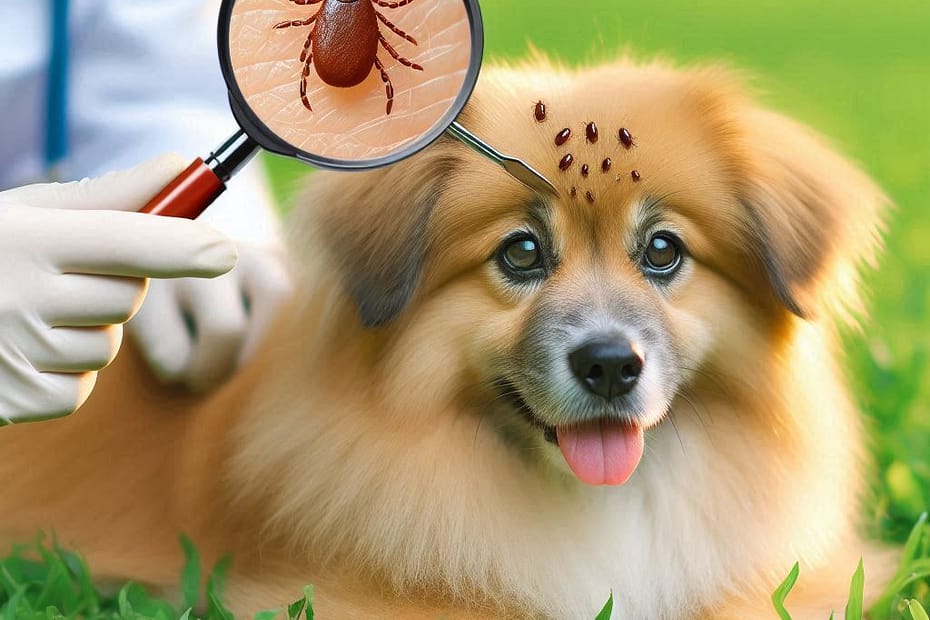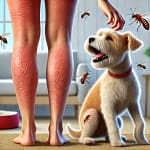Seed Ticks on Dogs: A Concern
Seed ticks are a type of tick that can infest dogs, causing discomfort and potential health risks. While they are smaller than adult ticks, they can still transmit diseases like Lyme disease, anaplasmosis, and babesiosis.
Identifying Seed Ticks:
- Size: They are very small, often appearing as tiny black or brown specks.
- Location: They often attach to the dog’s head, ears, and neck.
Health Risks:
- Tick-borne diseases: As mentioned above, seed ticks can transmit various diseases to dogs.
- Irritation: Bites can cause itching, redness, and discomfort for the dog.
Prevention and Treatment:
- Regular checks: Examine your dog for ticks, especially after spending time outdoors in grassy or wooded areas.
- Tick prevention products: Consult with your veterinarian about appropriate tick prevention products like topical treatments, oral medications, or collars.
- Grooming: Regularly brush your dog to help remove ticks and prevent infestations.
- Avoid tick-infested areas: If possible, avoid walking your dog in areas known for high tick populations.
- Veterinary care: If you find a tick on your dog or suspect a tick-borne illness, consult with your veterinarian for proper removal and diagnosis.
Remember, early detection and prevention are key to protecting your dog from seed tick infestations and the associated health risks.
Removing seed ticks from a dog requires careful attention and a gentle approach.
Here’s a step-by-step guide on how to remove seed ticks from your dog:
- Prepare the necessary tools: You will need fine-tipped tweezers or tick removal tools, rubbing alcohol, cotton balls or swabs, and a small container or ziplock bag.
- Find a well-lit area: Choose a location where you can clearly see the seed ticks on your dog’s body. Natural sunny light or a bright lamp can be helpful.
- Remember to Calm your dog: Ensure that your dog is calm and relaxed before attempting to remove the seed ticks. If necessary, get someone assists you in keeping your dog calm and still.
- Wear protective gloves: Wear disposable gloves to protect your hands during removal.
- Begin removal: Use the tweezers or other tick removal tools to gently grip the tick as close to the skin as you can, starting with the locations where you can see the seed ticks. The tick should not be squeezed or crushed to reduce the chance of spreading the disease.
- Steady removal: Pull the tick out straight and gently yet steadily. To prevent the tick’s mouthparts from breaking off and remaining in the skin, avoid twisting or jerking.
- Check for remaining ticks: Examine your dog’s entire body, paying special attention to the areas between the toes, around the ears, and under the armpits. Use the same approach to get rid of any extra seed ticks you find.
- Disposal: To ensure they are destroyed, put the extracted seed ticks into a little container or zip-top bag filled with rubbing alcohol. By doing this, they can’t reattach your dog or invade your house.
- Clean the bite areas: Clean the bite places on your dog’s skin with a mild antiseptic or rubbing alcohol after the seed ticks have been removed. A cotton ball or swab can be used to gently clean the area.
- Monitor for signs of infection: Watch out for any infection-related symptoms including redness, swelling, or discharge in the bite locations. Consult your veterinarian if you experience any alarming symptoms.
- Prevent future infestations: Consider utilizing the proper tick preventatives suggested by your veterinarian to reduce the likelihood of subsequent seed tick infestations. Oral drugs, topical remedies, and tick collars are a few examples of them.
Seed ticks can transmit ehrlichiosis to dogs
Ehrlichiosis is a tick-borne disease caused by bacteria that infect the dog’s white blood cells. Symptoms of ehrlichiosis can include fever, lethargy, decreased appetite, weight loss, and swollen lymph nodes. In severe cases, it can lead to internal bleeding, anemia, and even death.
What are the symptoms of ehrlichiosis in dogs?
Ehrlichiosis can cause a variety of symptoms in dogs, depending on the severity of the infection. Some common symptoms include:
- Lethargy
- Fever
- Decreased appetite
- Weight loss
- Swollen lymph nodes
- Coughing
- Difficulty breathing
- Bleeding gums or nosebleeds
- Vomiting and diarrhea
- Limping
- Seizures
It’s important to note that these symptoms can also be caused by other health conditions, so it’s essential to consult with your veterinarian for a proper diagnosis.
Treatment for Ehrlichiosis:
Treatment for ehrlichiosis typically involves antibiotics to target the bacteria causing the infection. The specific antibiotic and duration of treatment will depend on the severity of the infection and your dog’s overall health.
In addition to antibiotics, supportive care may be necessary to address any secondary complications, such as anemia or internal bleeding.
Prevention:
- Regular tick checks: Examine your dog for ticks after spending time outdoors.
- Tick prevention products: Use veterinarian-recommended tick prevention products.
- Avoid tick-infested areas: If possible, avoid walking your dog in areas known for high tick populations.
If you suspect that your dog may have ehrlichiosis, it’s crucial to seek veterinary attention promptly. Early diagnosis and treatment can improve the chances of a successful recovery. The author is a veterinarian, gets tick borne Ehrlichiosis in clinic.

Dr. Suranjan Sarkar is a veterinarian and also a writer and editor for both print and digital with a love for travel, animal, and architecture. Much of his writing has focused on human and animal health and welfare. A life-long pet owner, His two favorite canine quotes are, “Be the kind of person your dog thinks you are,” and “Dogs communicate their feelings honestly and directly. There’s no hidden agenda or manipulation.”









